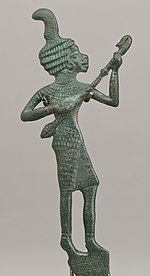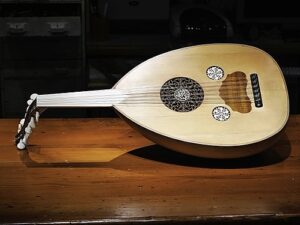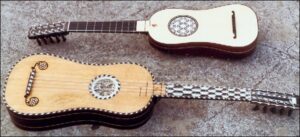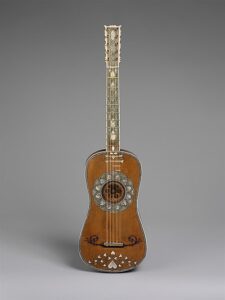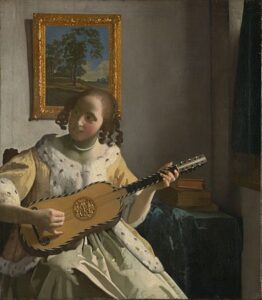
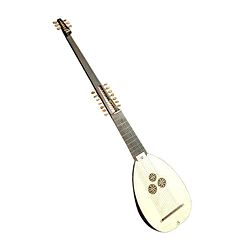 The guitar is a member of the lute family.
The guitar is a member of the lute family.
The Oldest Instruments
The oldest known member of the lute family dates from about 5000 years ago in Mesopotamia … an instrument called the Theorbo which is still played today.
There are a lot of different lute-like instruments depicted in art from ancient civilizations in places like Egypt, Central Asia, and Mesopotamia.
What’s the Actual Ancestor to the Guitar?
The first instrument called a guitar didn’t appear until about 1500. Although no one is completely sure, its actual ancestor is thought to be the Arabic oud, which is still popular today in the Middle East, Turkey and parts of Africa.
The shape is quite different from the guitar, with the tear drop body, rounded back and bent head stock. However, it is played quite like the guitar using a plectrum, and is also tuned in fourths like the guitar.
The Lute
The oud was brought to Spain in 711 when the Moors invaded Europe. The Spanish were completely enamored with the instrument and turned it into their own type of lute. This lute was played for hundreds of years.
The Renaissance (1450-1600) was the heyday of the lute. Although it still has the same shape as the oud, it had 7 strings …. 3 sets of double strings and a single one at the bottom. It was beginning to be played in the same way that we now play guitar, including chords. The tuning was much like the guitar, except that it had movable frets to accommodate the different styles of tuning of the day. Eventually the use of the pick was dropped in order to accommodate playing polyphonic compositions.
Lute players in this time period often had the ear of kings and courtiers, and quite often worked as spies!
The Renaissance Guitar
The Renaissance guitar appears around 1500. It has the same number of strings as the lute, but the body shape is beginning to change. It has an hour glass shape and a flat back.
The Renaissance guitar was not tuned like the lute, however. It was actually tuned like the ukulele. In fact, it was the Portuguese who took this guitar to Hawaii where it involved into the instrument we know as the ukulele today.
Although perfect for strumming (playing harmonies to accompany the voice), there is an extensive repertoire of beautiful solo pieces written for the Renaissance guitar, especially in France. It was played with the fingers, like the Spanish lute.
The Baroque Guitar
In the Baroque period (1600-1750), the guitar adds another course of strings which is tuned a fourth lower. The tuning would be like our guitar without the low E string. It was played either with a plectrum or strummed with the fingers in a style that foreshadows the Spanish Flamenco. It was really popular in Spain, but the style of playing was less appealing to people in other parts of Europe.
The new style of popular music that was emerging after 1750 was a return to more simple, beautiful melodies with accompaniment. These required more bass sounds, so by the end of the 18th Century, the final course of strings was added.
The Birth of the Modern Guitar
A more modern type of guitar arrives around 1800. It has 6 single strings and is tuned like a modern guitar, but still has the hour glass shape and is still smaller. Why the single strings? Winding the strings with metal had been invented, so they didn’t need the double strings to get the louder, richer sounds. The use of metal-wound strings and the adoption of equal temperament also meant that the moveable frets (which were quickly broken by the new strings) were replaced with fixed metal ones.
The guitar as we know it today was the invention of Antonio de Torres, a guitar maker from Spain. Guitars build by Torres were larger, featuring a broadened body, and an increased curve at the waist … it is said that the inspiration for the shape was the beautiful women he saw around him in Sevilla. This new shape gave the instruments a much richer tone.
Torres also reasoned that the soundboard on the guitar was key. To increase its volume, he made his guitars not only larger, but fitted them with thinner, lighter soundboards that were arched in both directions, made possible by a system of fan-bracing for strength.
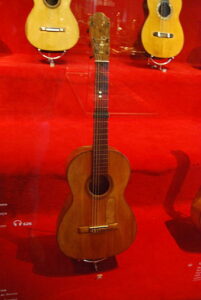 To prove that it was the top, and not the back and sides of the guitar, that gave the instrument its sound, in 1862 he built a guitar with back and side made of papier-mâché. That guitar can be found in the Museu de la Musica in Barcelona, and has even been restored to playable condition!
To prove that it was the top, and not the back and sides of the guitar, that gave the instrument its sound, in 1862 he built a guitar with back and side made of papier-mâché. That guitar can be found in the Museu de la Musica in Barcelona, and has even been restored to playable condition!
The dimensions codified by Torres are still used for Classical guitars today.
The guitar has remained one of the most popular instruments among both professional and aspiring musicians of all ages. The beauty and simplicity of the guitar’s sound make the instrument popular with listeners around the world.


